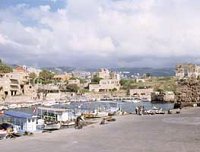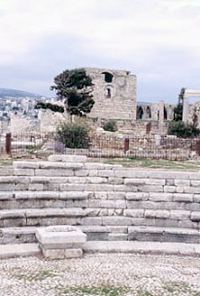

 Jbeil (Byblos)
Jbeil (Byblos)Altitude: 10 m
Distance from Beirut: 38km
Distance from Aboud: 23km
Byblos: The name originated from 'biblion', that is book. The word
'bible' is derived from the Greek 'ta b blia', which means 'the books'.
Byblos is the oldest continuously inhabited city in the world. According to
Phoenician tradition, Byblos was founded by the god El who surrounded his
city with a wall. The massive Early Bronze Age city walls (2800 B.C.) on the
site reflect this early religious belief. Thus Byblos was considered, even
by the ancient Phoenicians, to be a city of great antiquity.
Yet Byblos was inhabited even earlier. About 7,000 years ago a small fishing
community settled there. Several monocellular huts with crushed limestone
floors can be seen today on the site.
Long before Greece and Rome, this ancient town was a powerful, independent
city-state with its own kings, culture and flourishing trade. The kings of
Byblos used hieroglyphics and adopted the Egyptian cartouche for their names
and titles. Thus an alphabetic phonetic script was developed at Byblos, the
precursor of our modern alphabet. The inscription on the sarcophagus of King
Ahiram of Byblos (in the period 1200-1000 B.C.), presently in Beirut
National Museum, is the earliest form of the Phoenician alphabet yet
discovered.
One of the earliest attempts at city planning was conceived in Byblos. The
city was surrounded by a massive wall, a narrow winding street led from the
centre, secondary lanes branched off taking irregular paths among the
houses. In 2800 B.C. a large temple was built to Baalat Gebal, the 'Lady of
Byblos', the city goddess. Another temple was erected in 2700 B.C. to a male
god, called the 'Temple en L', this large construction faces that of Baalat
Gebal.
During the Roman period large temples and civic buildings were built, a
street colonnade surrounded the city. There are few remains of the Byzantine
and Arab period. Byblos fell to the Crusaders in A.D. 1108. They came upon
the large stones and granite columns of the Roman temples and public
buildings and used them to build their castle and moat.
Excavations over the past fifty years have made Byblos one of the unique
archaeological sites in the world with a history that spans seven thousand
years.
The four main places of interest to visit in Byblos are the Castle, built by
the Crusaders in the 12th and 13th centuries: the Egyptian temples, the
earliest of which dates back to the 4th millennium: the Phoenician royal
necropolis, and the Roman amphitheatre.